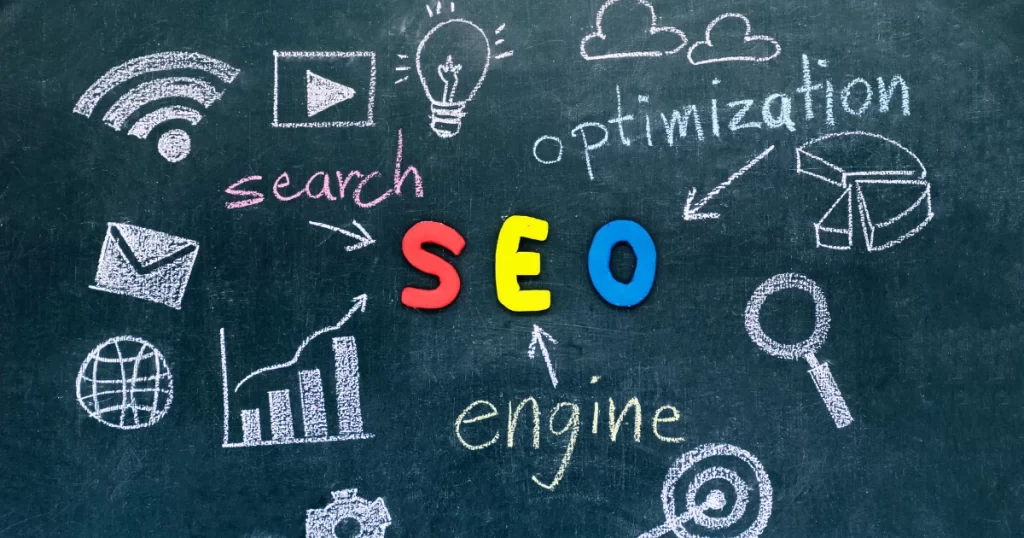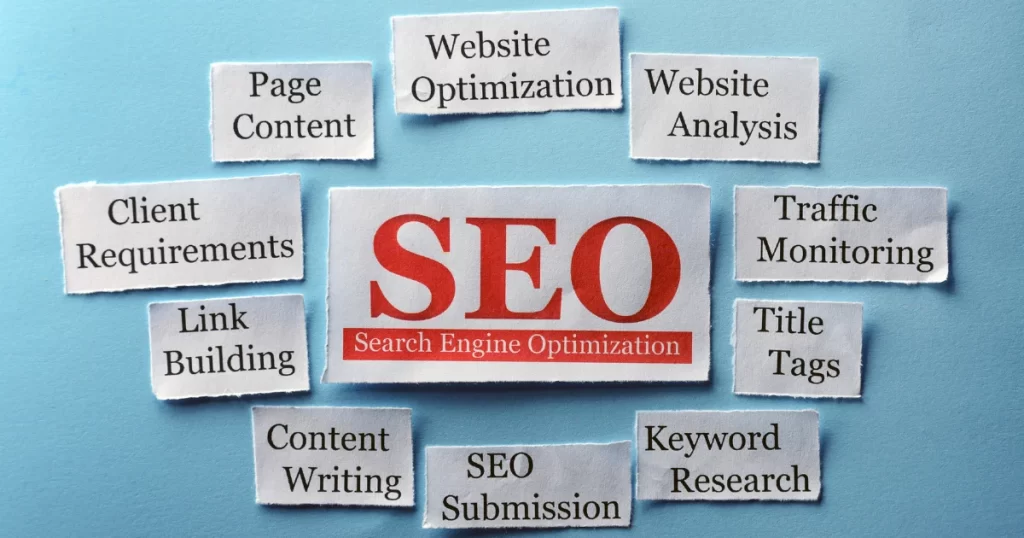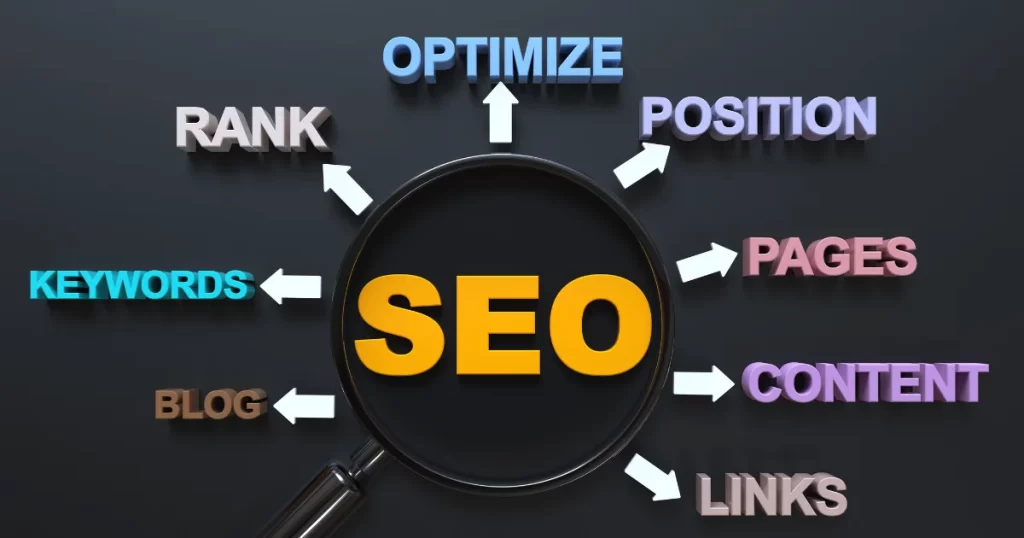SEO optimization: the two words that either make your heart flutter with excitement or send you spiraling into existential dread. But hey, if you’ve landed here, chances are you’re looking to boost your website’s ranking without sacrificing your will to live. Lucky for you, I’ve got the secret sauce to help you navigate the labyrinth of SEO without losing your mind (or your rankings).
Here’s the deal: SEO optimization is the not-so-secret weapon to climb the search engine ladder, grab more eyeballs, and (hopefully) convert those eyeballs into loyal customers. Stick around, and I’ll walk you through the best 10 SEO optimization strategies that’ll have your website soaring faster than a caffeine-fueled eagle.
1. Understanding SEO Best Practices: The Basics of Not Screwing It Up

Let’s start with the fundamentals of SEO—the bread and butter, the PB&J, the… you get the point. You can’t build a skyscraper without a solid foundation, and you can’t rank on Google without mastering the basics.
On-Site Optimization Techniques That Actually Work
Think of your website as a first date. You want it to be attractive, engaging, and easy to navigate. If it’s slow, messy, or incoherent, guess what? Your visitor is ghosting you for a competitor.
- Title Tags and Meta Descriptions: These are the pickup lines of SEO. They’re the first thing users see when your site pops up in search results.
- Bad Example: “Home Page.”
- Good Example: “Unlock the Secrets to SEO Success – Your Ultimate Guide.”
- Why? Because people are drawn to intriguing, specific, and action-oriented titles.
- Content Structure: Walls of text are to readers what unsolicited “k?” texts are to relationships—annoying and dismissive. Use headings, bullet points, and short paragraphs to make your content digestible.
The Role of Backlink Building in SEO Success
Backlinks are like trust fund money—if you have enough of the good kind, people assume you’re important. Google’s algorithm works similarly. High-quality backlinks signal that your content is credible and worth ranking.
How to Build Backlinks Without Losing Your Soul:
- Collaborate with Influencers: Slide into their DMs (politely) and propose mutually beneficial partnerships.
- Guest Blogging: Write stellar content for someone else’s blog and sneak in a link to your site. It’s like being a ninja, but with words.
- Broken Link Building: Find broken links on other websites, then swoop in with your content as the perfect replacement. You’re basically the Batman of SEO.
2. Content Optimization Strategies for Higher Rankings: Write Like You Mean It
Content isn’t just king—it’s the entire monarchy. But not just any content. Google isn’t impressed by a mediocre 300-word blog post about “Top 5 Ways to Lose Weight by Staring at Your Ceiling.” Your content needs to be so good, readers feel smarter just by scrolling through it.
Creating High-Quality Content That Ranks Well
- Be Original: Plagiarism is not flattery; it’s lazy. Find a unique angle on your topic to stand out.
- Use Visuals: Humans are visual creatures. Add infographics, charts, and videos to keep your readers hooked.
- Answer Questions: Use tools like Google’s “People Also Ask” to address real questions your audience is searching for.
Updating Existing Content for Continued Relevance
Your old blog posts are like that pair of jeans you haven’t worn since 2016. They’re still good but need a bit of tailoring. Regularly update your content to:
- Fix outdated statistics or broken links.
- Add new insights or research.
- Optimize for emerging keywords.
3. Enhancing User Experience (UX): Because Nobody Likes a Slow Website

A slow website is like waiting for a sloth to finish a marathon—painful and unnecessary. If your site isn’t fast, responsive, and easy to navigate, your visitors will bounce faster than a cat from a cucumber.
Mobile Optimization: A Must-Have, Not a “Nice-to-Have”
With mobile usage dominating the digital world, your site needs to look good on every screen size.
- Responsive Design: Ensure your site adapts seamlessly to different devices.
- Clickable Elements: Buttons should be big enough for human fingers, not ant-sized clicks.
- Prioritize Speed: Use tools like Google PageSpeed Insights to identify what’s slowing you down.
4. Leveraging Performance Tracking Tools: Spy on Your Own Website (Legally)
SEO without performance tracking is like driving blindfolded—you’re going somewhere, but it’s probably a ditch. Thankfully, tools like Google Analytics and Search Console are here to save the day.
What to Track
- Crawl Errors: These are the potholes of the internet. Fix them to ensure your content gets indexed.
- Keyword Rankings: Monitor which keywords are driving traffic and which are just loafing around.
- Bounce Rate: High bounce rate? Your content isn’t engaging enough, or your UX needs work.
5. Optimizing Images: Because Pretty Pictures Matter Too
Let’s face it: we’re visual creatures. Even the most riveting blog post can feel like a slog if it’s paired with pixelated images or a page that takes longer to load than your grandma’s dial-up modem. Image optimization is the unsung hero of SEO optimization, balancing stunning visuals with lightning-fast performance. Here’s how to make your images work harder (and smarter):
Image Compression: The Art of Losing Weight Without Losing Quality
Large image files are like carrying a backpack full of bricks—they’ll slow you down. Compress your images to shrink their file size without turning them into pixelated messes. Tools like TinyPNG or ImageOptim are your best friends here.
- Before Compression Example:
File size: 5MB
Load time: 4 seconds - After Compression Example:
File size: 500KB
Load time: 0.5 seconds
File Formats: Choose Your Weapon Wisely
Not all image formats are created equal. Some are better for certain use cases:
| Format | Best For | Pros | Cons |
|---|---|---|---|
| JPEG | Photographs | Small file sizes, widely supported | Loses quality with every save |
| PNG | Transparent graphics, logos | High quality, supports transparency | Larger file sizes |
| WebP | Modern web images | Superior compression, supports transparency | Limited browser support |
💡Pro tip: Use WebP whenever possible—it’s like JPEG on steroids but without the side effects.
Descriptive File Names: Say Goodbye to “IMG1234.jpg”
Google’s bots can’t “see” your images, but they can read your file names. Replace vague names like “image1.jpg” with descriptive ones like “SEO-optimization-guide-cover.jpg.” It’s a quick win for improving image search rankings.
Alt Text: The MVP of Accessibility and SEO
Alt text isn’t just for accessibility (though that’s reason enough to use it). It’s also a prime spot to sneak in your SEO optimization keywords. Keep it descriptive but natural. For example:
- Bad Alt Text: “Image”
- Good Alt Text: “Infographic explaining the top 10 SEO optimization strategies”
Lazy Loading: Let’s Get Technical
Why load all your images at once when your users are only looking at the top of your page? Enter lazy loading—a nifty trick that defers loading off-screen images until they’re about to be displayed. This boosts page speed and keeps your bounce rate at bay.
Bonus Tip: Optimize Thumbnails
Thumbnails might be small, but they can make a big impact on load times. Compress them separately and use lower-quality settings since they’re not the main attraction.
6. Internal Linking Strategies: Connect the Dots

Internal linking isn’t just tossing hyperlinks around like confetti—it’s a calculated art form. Think of your website as a treasure map, and internal links are the trails leading visitors (and search engines) to the loot. Done right, internal linking can supercharge your SEO optimization efforts and keep readers exploring your site like it’s the best theme park ever.
Why Internal Linking Matters
Internal links do three critical things:
- Boost SEO: They help search engines crawl your site and understand its structure.
- Enhance User Experience: They guide readers to related content, keeping them engaged longer.
- Distribute Link Equity: They pass the SEO juice from high-authority pages to others, improving rankings across your site.
Best Practices for Internal Linking
- Use Keyword-Rich Anchor Text
Anchor text is the clickable part of a hyperlink, and it’s prime real estate for your SEO optimization keywords. Instead of saying, “Click here for more info,” say, “Learn more about SEO optimization strategies.” - Link to Relevant Content
Don’t send readers on a wild goose chase. If they’re reading about on-page SEO, link them to resources about meta descriptions, keyword research, or content structure—not your recipe for banana bread. - Prioritize Authority Pages
Identify the pages on your site with the highest authority (often your homepage or popular blog posts) and use them to bolster newer or lower-ranked pages. Think of it as sending SEO love down the chain. - Use a Logical Hierarchy
Structure your links like a family tree. The homepage is the “parent,” category pages are the “children,” and individual blog posts are the “grandchildren.” This keeps your site organized and easy to navigate. - Don’t Overdo It
Overloading a page with links looks spammy and confuses readers. Stick to 2-5 internal links per 500 words of content as a rule of thumb. - Audit Regularly
Use tools like Screaming Frog or Ahrefs to find broken links, orphaned pages, and other issues. A well-maintained linking strategy is like a well-oiled machine—it just works better.
7. Different Types of SEO: The Holy Trinity
SEO isn’t a one-size-fits-all magic trick; it’s a three-pronged approach. These “flavors” of SEO work together like a perfectly balanced meal—if one’s missing, the whole experience falls flat.
1. Technical SEO: The Backstage Crew
Technical SEO ensures your site’s foundation is solid. If your website were a stage production, technical SEO would be the crew making sure the lights work and the stage doesn’t collapse.
- Page Speed: Nobody likes a slow website. Tools like Google PageSpeed Insights can pinpoint what’s bogging you down.
- Structured Data: Schema markup helps search engines understand your content. Think of it as giving Google a cheat sheet.
- Mobile Friendliness: With mobile traffic dominating, your site needs to look and function like a dream on every device.
- Crawlability and Indexing: Ensure search engines can actually find and index your pages. Use robots.txt and sitemaps wisely.
2. On-Site SEO: The Star Performer
On-site SEO is all about what’s happening on your stage (read: website). This includes everything from content to keywords to user experience.
- Content Optimization: Create high-quality, keyword-rich content that answers user queries and provides value.
- Meta Tags: Title tags and meta descriptions are your first impression—make them count.
- Internal Linking: (See above. You’re welcome.)
- Keyword Placement: Strategically place your target keywords in headings, subheadings, and body text without sounding like a robot.
3. Off-Site SEO: The Hype Team
Off-site SEO is about building your site’s reputation and authority in the vast, chaotic landscape of the internet. Think of it as your PR campaign.
- Backlinks: High-quality links from other sites are like endorsements from celebrities—they boost your credibility.
- Social Signals: While not a direct ranking factor, an active social media presence can drive traffic and engagement.
- Brand Mentions: Even unlinked mentions of your brand can signal trust and authority to search engines.
8. Voice Search Optimization: Speak Now or Forever Miss Out

Welcome to the era of “Hey Google” and “Alexa, play Despacito.” Voice search is no longer a novelty—it’s how people are finding answers while multitasking. If you’re not optimizing for voice search, you’re leaving a massive slice of the SEO pie on the table.
Why Voice Search Matters
- Conversational Queries: People use natural language in voice search, which means long-tail keywords are your new BFF.
- Local Search Dominance: Voice search often involves location-based queries like “nearest coffee shop.”
Voice Search Optimization Tips
- Use Natural Language
Write your content as if you’re speaking to a friend over coffee. Instead of rigid keywords like “pizza delivery,” go for “Where can I order pizza near me?” - Answer Questions Directly
Featured snippets are prime real estate for voice search answers. Create FAQ sections or concise, well-structured answers to common queries. - Optimize for Mobile
Voice search is primarily mobile-driven, so double down on mobile optimization. Responsive design and lightning-fast load times are non-negotiable. - Focus on Local SEO
Claim your Google Business Profile and include location-specific keywords. Most voice searches are local, so be the business they find first.
9. Harnessing Social Media for SEO: Sharing is Ranking
Social media doesn’t directly impact rankings, but its indirect benefits are undeniable. A strong social presence can drive traffic, amplify your content, and build brand authority—all of which make search engines smile.
How to Use Social Media for SEO
- Share Your Content
Post your blog links, infographics, videos, or even memes on the platforms your audience loves. Don’t just drop links—add value with captions that hook readers. - Engage Actively
Respond to comments, answer questions, and join conversations. The more active you are, the more likely people are to share your content. - Leverage Social Sharing Buttons
Make it stupidly easy for readers to share your content. Place social sharing buttons where they’re impossible to miss. - Repurpose Content
Turn a blog post into a tweet thread, an Instagram carousel, or a LinkedIn article. Different formats = wider reach. - Collaborate with Influencers
Partner with influencers in your niche to amplify your reach. Their followers trust their recommendations, which can drive massive traffic to your site.
10. Local SEO Strategies: Put Your Business on the Map (Literally)
Ever heard the saying, “Think globally, act locally”? When it comes to SEO optimization, this couldn’t be more true. If your business relies on local foot traffic or services specific to your area, local SEO isn’t just a nice-to-have—it’s your bread and butter (or avocado toast, depending on your vibe).
Local SEO is how your bakery becomes the bakery, your coffee shop becomes the go-to caffeine fix, and your plumbing business becomes the knight in shining armor for leaky faucets. Let’s dive into the nitty-gritty of dominating “near me” searches and skyrocketing your visibility in your community.
Why Local SEO Matters
Local SEO isn’t just a strategy—it’s a lifeline for businesses that depend on attracting customers within a specific geographic area. Here’s why:
- 46% of all Google searches are local. Translation: People are constantly looking for nearby solutions.
- 88% of local mobile searches result in a visit or call within 24 hours. If you’re not optimized, that’s a lot of missed opportunities.
- Google loves local businesses. Features like Google Business Profile (GBP) make it easier for small businesses to shine.
Local SEO Action Plan
Step 1: Claim and Optimize Your Google Business Profile (GBP)
If you haven’t claimed your GBP yet, stop reading, open a new tab, and do it now. Seriously. This is ground zero for local SEO domination.
- Fill Out Every Field: Don’t half-ass this. Include your business name, address, phone number (NAP), website, operating hours, and a detailed description of what you do.
- Choose the Right Categories: Be specific. If you’re a vegan bakery, choose “Vegan Bakery” instead of just “Bakery.”
- Add Photos: High-quality images of your storefront, products, and team make you relatable. Bonus: Businesses with photos get 42% more requests for directions.
- Keep It Updated: Changed your hours for the holidays? Ran out of avocado toast? Update your profile immediately.
| GBP Optimization Checklist | Done (✔) |
|---|---|
| Business name, address, and phone number updated? | ✔ |
| Business category selected? | ✔ |
| High-quality photos uploaded? | ✔ |
| Operating hours accurate? | ✔ |
| Website link added? | ✔ |
Step 2: Encourage Glowing Reviews (Without Being Pushy)
Positive reviews can do more than inflate your ego—they influence how you rank in local search results. Plus, they’re the digital equivalent of word-of-mouth marketing.
- Ask Politely: After a purchase or service, ask happy customers to leave a review. Something simple like, “We’d love your feedback on Google!” works wonders.
- Make It Easy: Provide direct links to your review page via email or text.
- Respond to Every Review: Yes, even the bad ones. Thank positive reviewers and address negative feedback with grace (no one likes a defensive business owner).
- Highlight Reviews in Your Content: Got a glowing testimonial? Feature it on your website or social media to build trust.
Step 3: Use Local Keywords Like a Pro
Your SEO optimization efforts are incomplete without local keywords that scream, “Hey, I’m in your neighborhood!”
- Be Specific: Instead of targeting generic keywords like “Italian restaurant,” go for “Best Italian restaurant in Brooklyn.”
- Think Like a Customer: What would you type if you needed your service? Use those phrases.
- Don’t Forget Long-Tail Keywords: Voice search often involves longer, conversational queries. For example, “Where can I find the best tacos near me?”
| Keyword Examples for Local SEO |
|---|
| “Affordable plumbers in Austin” |
| “Pet-friendly cafes in San Diego” |
| “Top-rated yoga studio in Chicago” |
| “24-hour locksmith in Seattle” |
| “Best gluten-free bakery in Denver” |
Step 4: Optimize for Mobile Users
Most local searches happen on mobile devices. If your website isn’t mobile-friendly, you’re essentially turning away potential customers at the door.
- Responsive Design: Ensure your site adapts to any screen size.
- Fast Load Times: No one’s waiting 10 seconds for your page to load. Use tools like GTmetrix to identify speed issues.
- Click-to-Call Buttons: Make it stupidly easy for mobile users to call you with a single tap.
Step 5: Get Listed in Local Directories
The more places your business appears online, the more legitimate it looks to search engines. Focus on these key directories:
- Yelp
- Yellow Pages
- Bing Places for Business
- TripAdvisor (if applicable)
- Industry-specific directories
💡Pro Tip: Consistency is Key. Your NAP information must match across all platforms. If your address is listed as “123 Main St.” on Google, don’t list it as “123 Main Street” elsewhere.
| Top Directories for Local SEO |
|---|
| Google Business Profile |
| Yelp |
| Yellow Pages |
| Bing Places |
| TripAdvisor |
Step 6: Leverage Local Content
Want to stand out? Create content that resonates with your local audience.
- Blog About Local Events: Write posts like, “Top 5 Things to Do in [Your City] This Weekend.”
- Sponsor Community Events: Support a charity run or local festival and promote it on your site.
- Highlight Customer Stories: Share testimonials or case studies from local customers.
Conclusion: Your Local SEO Optimization Battle Plan
And that’s a wrap—your comprehensive guide to mastering SEO optimization for local success. By claiming your Google Business Profile, encouraging rave-worthy reviews, and strategically integrating local keywords, you’re not just playing the SEO game—you’re redefining it.
But remember, SEO optimization isn’t a one-time effort; it’s a continuous journey. Regularly monitor your analytics, keep refining your strategies, and always stay a step ahead of your competition. Consistency is the secret sauce that makes SEO optimization work like magic.
Whether it’s updating your Google Business Profile, writing engaging local content, or responding to customer reviews, every action you take contributes to your SEO optimization goals. Sprinkle those location-specific keywords throughout your website, and make sure your mobile optimization game is on point. After all, a poorly optimized site is the digital equivalent of a “closed” sign on your storefront.
Don’t shy away from experimenting either. The beauty of SEO optimization is that it’s flexible. If something doesn’t work, tweak it. Test different approaches, analyze the results, and adapt. Whether you’re running a local bakery, a pet grooming salon, or a tech repair shop, SEO optimization can drive the visibility and credibility your business deserves.
Oh, and let’s not forget the importance of reviews—stellar reviews are gold in the realm of SEO optimization. They not only help your rankings but also establish trust with potential customers. So, go ahead and encourage your happiest clients to share their experiences online.
In the end, SEO optimization isn’t about tricking search engines; it’s about creating an authentic online presence that connects with your community. Stay creative, stay committed, and watch your local rankings climb higher than ever.
Now, go conquer those search results like the SEO-savvy champion you are. And if Google does accept cookie bribes, let me know—I’m asking for a friend.





